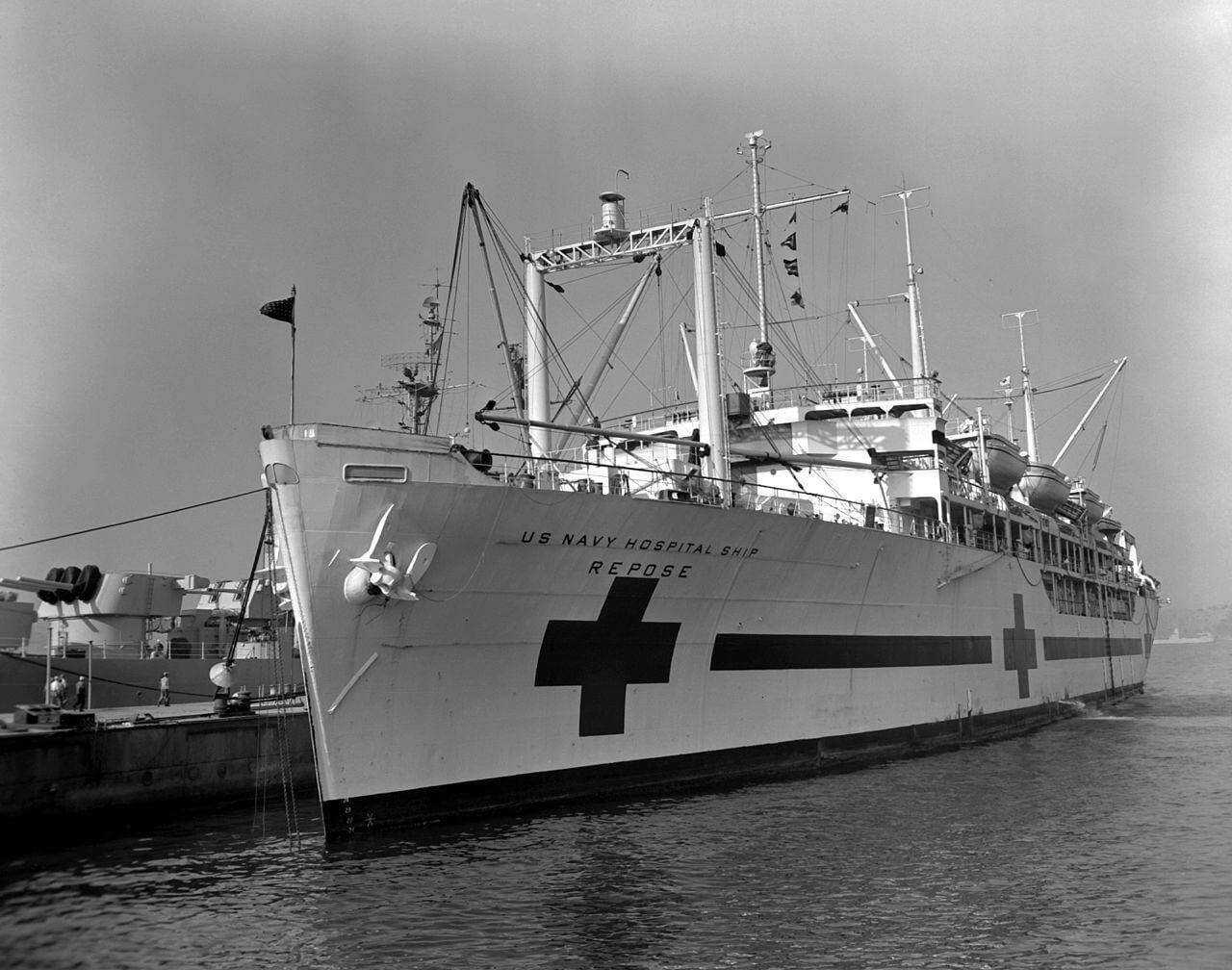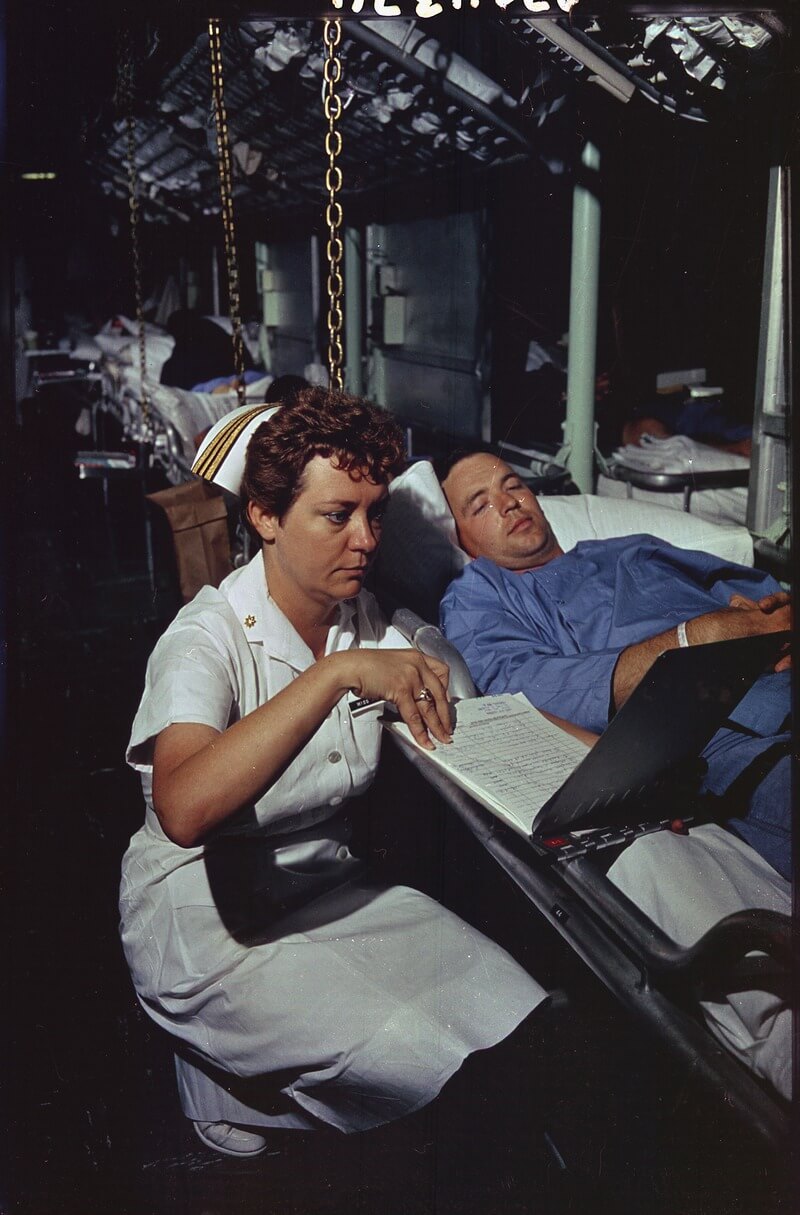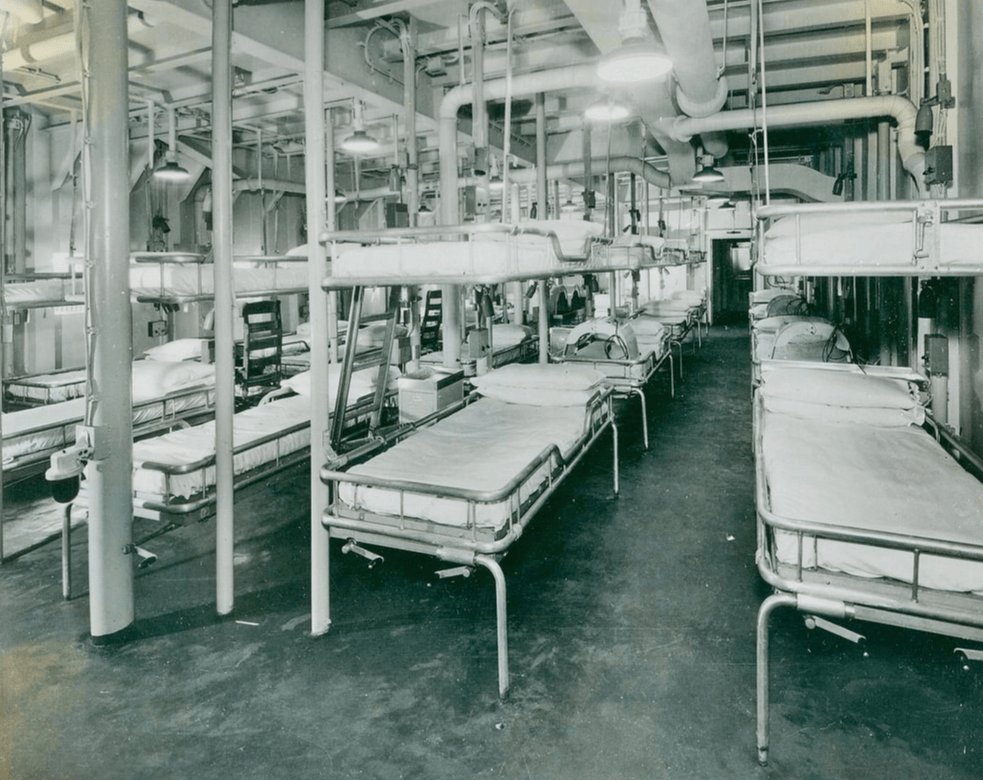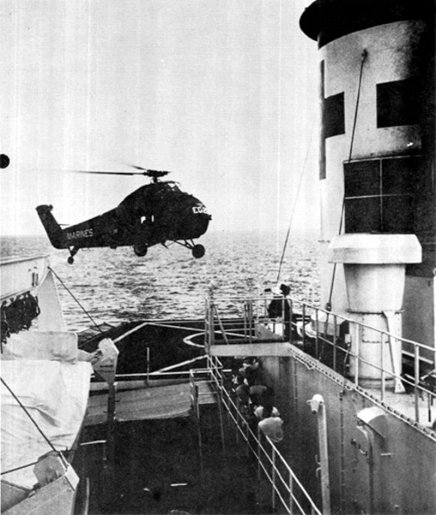
 A Minnesota PBS Initiative
A Minnesota PBS Initiative
The USS Repose, hospital ship is steaming on the Gulf of Tonkin, some three miles off the coast of Da Nang, Vietnam. The ships Captain receives Orders from the Chief Medical Officer to leave the war zone and sail to the Philippines with a full load of 1,000 patients from the Tet Offensive. It only took twelve days to fill up.
"Must be a bad one out there," the Captain thinks. They leave under the cover of darkness so the enemy will not know of its' mission.

The U.S. Navy hospital ship USS Repose (AH-16). Photo courtesy of U.S. National Archives.
The ship has a variety of sick and injured patients, many critical as a result of sniper fire to the head. Our only Neuro Surgeon, is a huge "Teddy Bear" kind of guy. I wonder how he can manage all that delicate surgery with such large hands...
Neuro patients are lined up on stretchers in the hall adjacent to the Recovery Room, waiting for his assessment. All are comatose, and attended by a Corpsman The Neuro-Surgeon prioritizes their ability to survive surgery. If they have signs of agonal breathing (Deep, irregular & rapid), he will order them transported inside the R.R. for Comfort Cares only, until they expire in an hour or two... There are so many casualties that some of the corpses are stored in empty freezer space.
Forty two hours later we arrive in Subic Bay and enter the port of Olongopo. A parade of ambulances is waiting on the pier for the transfer of the sickest patients. The ambulatory patients will be loaded on convoy trucks for the 80 mile trip to Clark Air Fore Base.
Everyone handles the mental and physical trauma differently. Sometimes it lingers, other times not. Hopefully, they will have the strength to endure.
There is no customary lineup in dress uniform of the crew around the main deck as the ship docks. They are too busy getting patients ready to disembark ASAP. The lonely tugboat strains as it pushes the huge ship to the pier. Several hours later the ship is empty.
The sickest patients are Red Lighted to Clark, now in the care of our medical Brothers & Sisters from the US Air Force. A myriad of paper work accompanies each patient. As the last of the ambulances pull away, a sense of relief and accomplishment is felt by our medical staff. Some wonder how their wounded comrades will cope once out of the ships air conditioning as the jungle heat is relentless. Many already have fevers.
As a Navy Corpsman, I think of several patients from my ward that left our domain and once at Clark AFB will be flown via special equipped jet aircraft to San Diego, then transferred to the huge Balboa Naval Hospital for tertiary treatment and care.
What will their future hold? I cannot help but wonder if their family will be there for them? Or, will he be there for his family long term? Everyone handles the mental and physical trauma differently. Sometimes it lingers, other times not. Hopefully, they will have the strength to endure. One can only hope and pray for the best.
The ship seems empty and hollow now. But, it gives us a chance to debark on a couple days of liberty while it is resupplied.

Lieutenant Commander Dorothy Ryan checks the medical chart of Marine Corporal Roy Hadaway aboard the hospital ship USS repose off South Vietnam. Photo courtesy of Department of Defense. Department of the Navy. U.S. Marine Corps. 09/18/1947.

The beds, or what the Navy called "Racks," are two high. That is too save space. The sicker patients or the ones that required the most care were on the bottom Racks. The Psych Ward was located on the deck (Floor) above & the Racks were five high as all patients were ambulatory, and the ward held 250 patients...The ORs, Recovery Room, Lab & CSR were on the lowest level because it was the most stable during rough seas. Photo courtesy of Navy Medicine: Hospital ship USS Repose (AH-16) commissioning on 26 May 1945.
The small town of Olongopo, Philippines awaits. One uses the Buddy System and walks over a two lane bridge that has earned the name: "Sh--t River!" The water is only 3 feet deep and is full of kids who immediately holler, "Sailor throw me coin," in a repetitive chant. Probably the only English they know?
Most sailors respond by throwing US quarters just out of their reach so they are required to dive in the murky water then use the brail system to find them. Unfortunately, the water reeks from the town's raw sewage & chemicals dumped into it from the dilapidated wooden shanty's that line it's banks. The kids seem oblivious but I wonder what their health and longevity will be. Their world certainly is unknown and unsettled.
The town is essentially a four block main street lined with numerous saloons and eateries, that resemble the Wild, Wild West of years past.
Parked outside the bars are ten, used American Jeeps that were abandoned after WWII, or determined too expensive to ship back to the states? The "Jeepnies" as they are now called, are now used as taxis by the locals. Each one is decorated in bright, bold colors with various forms of memoralbia such a colorful pinwheels. They have canopies in a myriad of colors to keep out the daily rains at 1600 hours. One can almost set his watch when the rain starts. (Ha)
Each driver tries to outdo each other and uses various wild decorations to entice the American customers. Most sailors jump on for a taste of the visual experience. (If only we had the yet to be invented cell phones for pictures...)
The Jeepnies bounce as they crawl from hole to hole in the pock marked main street. The drivers do not slow down, just like taxis in the states.
Those sailors who choose to walk are met by hordes of boisterous kids who want to shine their shoes. If one refuses, they threaten to smear shoe polish on ones uniform, or steal your white hat for ransom. Most sailors feel sorry for the kids and relent. Some still refuse and enter a bar for a drink and entertainment. The kids follow, trying to sell them Juicy Fruit gum or even their sister. It's an endless noisy cycle. Each bar has a rock band of some kind. Instead of Rock and Roll, they call it "Rock-a-Billy. A few are very talented and could probably get jobs in the states.
Street vendors try to sell cooked chicken or, Baluts that look like boiled eggs but are unborn chick embryos that are considered a delicacy. One pokes a toothpick into one end and sucks out the juice... The Navy had warned us of such and to eat only in eateries that have an "A" posted in the window. I see none...
Other sailors decide to take a Navy Landing Craft on the waters of Subic Bay about four miles out to Grande Island. The island is forty acres groomed by our military. It has a large canteen with meals plus a 9 hole golf course, a pleasant reminder of home. The island was captured by the Japanese during WWII and used as strategic fortress to the entry of the harbor. It has damaged but still intact rusty, cannon-style guns and bunkers that can be explored at will. A popular photo op.
Some sailors overindulge at the canteen and get sick from the rough waters on the return trip to the base. The remainder of the time on the docked ship is spent organizing the new supplies, taking inventory, and performing some needed cleaning and sanitizing.
Once resupplied, the Repose steams back to Vietnam, sailing up and down the coast, again three miles out. The sound of "Flight Quarters" over the intercom signals patients are on the way transporting unfortunate wounded and sick Marines & Soldiers. The cycle continues.

A Sikorsky UH-34D Seahorse of Maine Medium Helicopter Transport Squadron 263 (HMM-263) prepares to land wounded on the U.S. Navy USS Repose (AH-16) off the coast of Vietnam, in 1966. Photo courtesy of U.S. Navy.
(On one subsequent trip to Subic Bay we were not allowed Liberty because it was election day. The local elections tend to get violent at times. As luck would have it one of the Contestants was shot in Olonopo. We hear to ambulance sirens approaching with the wounded man onboard. There was no warning other than the siren. they came roaring over the bridge through the gate and up to the ship. The patient was transported on to the ship despite regulations against treating civilians. I never heard how the Navy handled the politics.,,)
Story Themes: 1964, 1965, 1966, 1967, 1968, Brent Hanson, Da Nang, Medical Personnel, Minneapolis, Navy, Olo, Philippines, Read, Tet Offensive, USS Repose